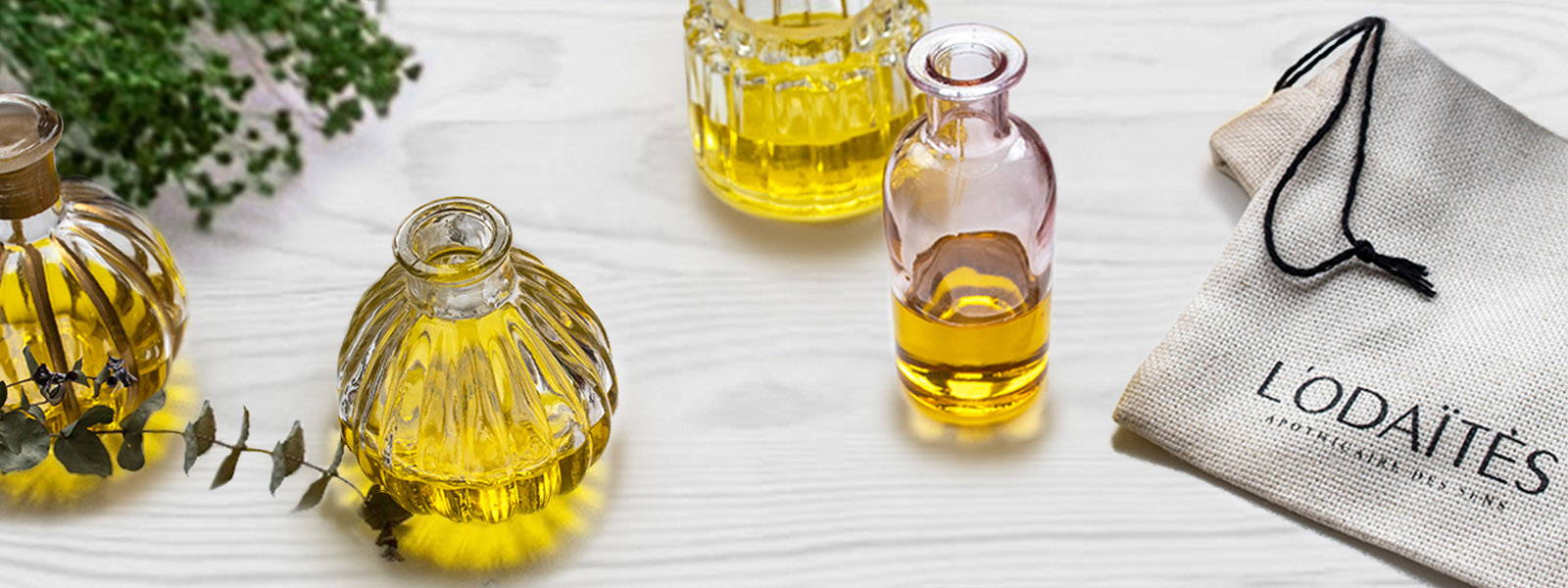
Comment bien comprendre les huiles qui composent vos cosmétiques ?
Les huiles représentent un ingrédient majeur de nos cosmétiques mais pour autant elles ne se valent pas toutes et la différence est de taille ! Elles peuvent être d’origine minérale ou d’origine végétale. Les huiles minérales, dérivées du pétrole, sont utilisées pour la qualité des textures qu’elles procurent aux soins. Elles sont inertes par essence et sont un recours pour ceux qui recherchent de faibles prix de revient. Elles sont évidemment dépourvues de tout nutriment contrairement à une huile végétale extraite de fruits ou graines oléagineux. Mais pour que cette huile végétale offre à votre peau souplesse, fermeté, hydratation et toute autre bénéfice, il faut veiller à choisir le mode d’extraction permettant de préserver au maximum sa richesse biologique ! Dans cet article, nous proposons de vous éclairer sur la composition biochimique des huiles végétales, de vous permettre de les décoder dans la liste INCI de vos soins et de comprendre l’intérêt cosmétique d’une huile vierge pour votre peau.

NABILA
Avril 2021
1. HUILE HYDROGÉNÉE
L’huile hydrogénée est une huile végétale extraite à très haute température par une réaction d’hydrogénation modifiant ainsi sa structure biochimique pour un produit plus ou moins solide et insensible à toute oxydation. Elle est moins chère car l’opération d’hydrogénation donne un fort rendement mais « l’huile » obtenue ne présente aucun bénéfice pour la peau. Il faut savoir que ce type d’huile est aussi utilisé dans les préparations alimentaires industrielles (viennoiseries, plats cuisinés, margarine, etc.) mais l’opération de transformation génère un mauvais type d’acides gras -acides gras trans- qui a amené l’ANSES à instaurer une limite de leur apport dans notre alimentation. Dans les soins cosmétiques, vous pourrez les repérer facilement dans la liste INCI car leur dénomination comprend le terme « Hydrogenated ». Par exemple, une huile d’olive hydrogénée est dénommée Hydrogenated Olive Oil. Ces huiles sont acceptées par le référentiel COSMOS donc pour le label Bio.
2. HUILE ESTÉRIFIÉE
L’huile estérifiée est une huile végétale, souvent huile de palme ou coco, dont les molécules ont été brisées par réaction chimique pour être associées à un autre ingrédient, généralement des alcools gras naturels ou synthétiques. Cette opération de transformation donne naissance à une « huile » dénaturée qui offre une plus grande stabilité aux formules. Son coût est, de fait, moins élevé que le coût d’une huile végétale. Elle a une action émolliente et donne au soin une texture agréable parfois plus pénétrante mais il y a une perte de principes actifs comparé à l’huile végétale d’origine.
Elle peut être obtenue selon les principes de la chimie verte et est acceptée par le référentiel COSMOS. Elle est totalement biodégradable. Voici quelques exemples de dénomination d’huile estérifiée que vous pourrez retrouver dans la liste INCI des ingrédients de vos soins : Caprylic Capric Triglycerides, Isopropyl Palmitate, Coco Caprylate Caprate, Oleyl Linoleate...
3. HUILE VÉGÉTALE VIERGE OU RAFFINÉE
- Les triglycérides sont des lipides composés de divers acides gras qui fournissent l’énergie à notre corps.
- Les insaponifiables, désignés ainsi pour signifier la composante de l’huile qui ne se transforme pas en savon, sont des composants extrêmement précieux pour la peau. On y retrouve les vitamines, les stérols, les caroténoïdes, les polyphénols, le squalène, etc.
L'EXCTRACTION PAR PRESSION MÉCANIQUE
qui permet de préserver toute la richesse biologique et donne une huile pure qualifiée d’huile vierge.L'EXTRACTION PAR SOLVANTS
qui vise à soustraire les substances réactives - minéraux, vitamines, fibres, etc.- pour permettre un long stockage sans altération et qui donne une huile moins chère dite huile raffinée. Mais ces substances réactives soustraites sont une mine d’or pour notre peau.
Ainsi une huile raffinée est appauvrie de ses acides gras essentiels et de ses composants insaponifiables qui sont de puissants actifs à l’origine d’une peau ferme, hydratée, repulpée, dense et vigoureuse. Même si les formulateurs évitent les huiles vierges car difficiles à stabiliser dans le temps, nous restons parmi les rares formulateurs et marques à avoir réussi le pari de formuler des soins à base d’huiles vierges comme substance active pour offrir ainsi le meilleur à votre peau. Ce pari s’est traduit notamment dans le choix incontournable de conditionnements sombres à l’abri de la lumière ou encore sous vide sous gaz inerte pour certains afin de préserver intact les bénéfices et la qualité des huiles vierges composant nos soins.
Les huiles végétales présentes dans un soin cosmétique sont dénommées dans sa liste INCI par leur nom latin. Vous retrouverez par exemple l’huile de jojoba par cette dénomination « SIMMONDSIA CHINENSIS SEED OIL » mais malheureusement la dénomination ne permet pas de distinguer la qualité vierge ou raffinée de l’huile.
Par ailleurs, il est bon de savoir qu’il existe des huiles végétales comédogènes c’est-à-dire susceptibles de provoquer des comédons favorisant ainsi l’apparition de points noirs et de boutons. Il existe un indice qui classe leur pouvoir comédogène de 0 à 5. Il faut généralement éviter l’usage fréquent d’une huile possédant un niveau d’indice au-delà de 3 pour les peaux grasses et au-delà de 4 pour les peaux sèches. Les huiles végétales que nous utilisons ont un indice de comédogénicité bas avec un niveau égal à 0 pour l’huile de pépins de figue de barbarie, de jojoba et de tournesol et un niveau égal à 2 pour l’huile d’amande douce, de noyaux d’abricot, de dattier du désert, de macadamia, de moringa et d’olive.
L'huile de coco ou de germe de blé sont des huiles à indice de 5 donc à éviter ou à consommer avec parcimonie même si elles jouissent d’autres vertus. Vous ne les retrouverez pas chez L’ODAÏTÈS. Cependant il est délicat de donner une règle générale pour un soin contenant de telles huiles car il faut l’apprécier dans sa globalité et tenir compte de la spécificité de la peau ainsi que de la qualité des ingrédients et de la formule. C’est aussi au formulateur cosmétique d’équilibrer sa formule.
Comme il existe une multitude d’huiles végétales, nous partagerons avec vous des conseils plus précis lors d’un prochain article sur le type d’huile à adopter pour chaque type de peau. Ceci dit, plus une huile végétale sera riche en insaponifiables plus votre peau pourra en tirera bénéfice. Sachez enfin que l‘huile de jojoba, qui n’est pas véritablement une huile mais une cire, convient à merveille à tous les types de peau. Vous la retrouvez dans notre crème intense, dans notre sérum redensifiant, dans notre crème corps et dans notre baume nourrissant.


